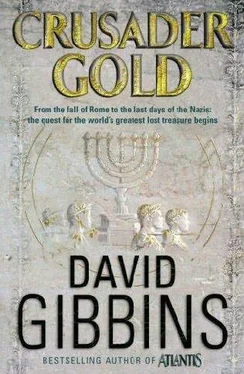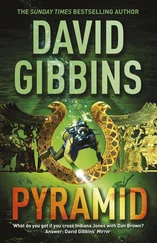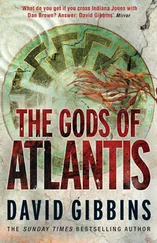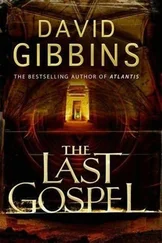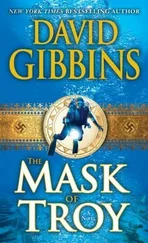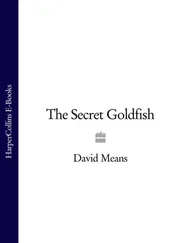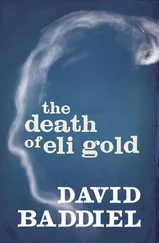David Gibbins - The Crusader's gold
Здесь есть возможность читать онлайн «David Gibbins - The Crusader's gold» весь текст электронной книги совершенно бесплатно (целиком полную версию без сокращений). В некоторых случаях можно слушать аудио, скачать через торрент в формате fb2 и присутствует краткое содержание. Жанр: Прочие приключения, на английском языке. Описание произведения, (предисловие) а так же отзывы посетителей доступны на портале библиотеки ЛибКат.
- Название:The Crusader's gold
- Автор:
- Жанр:
- Год:неизвестен
- ISBN:нет данных
- Рейтинг книги:3 / 5. Голосов: 1
-
Избранное:Добавить в избранное
- Отзывы:
-
Ваша оценка:
- 60
- 1
- 2
- 3
- 4
- 5
The Crusader's gold: краткое содержание, описание и аннотация
Предлагаем к чтению аннотацию, описание, краткое содержание или предисловие (зависит от того, что написал сам автор книги «The Crusader's gold»). Если вы не нашли необходимую информацию о книге — напишите в комментариях, мы постараемся отыскать её.
The Crusader's gold — читать онлайн бесплатно полную книгу (весь текст) целиком
Ниже представлен текст книги, разбитый по страницам. Система сохранения места последней прочитанной страницы, позволяет с удобством читать онлайн бесплатно книгу «The Crusader's gold», без необходимости каждый раз заново искать на чём Вы остановились. Поставьте закладку, и сможете в любой момент перейти на страницу, на которой закончили чтение.
Интервал:
Закладка:
“How long has it been there?” Jack said.
“About three months. Lanowski’s run a simulation that shows it processing down the fjord and jamming against the threshold. Any chance of seeing it?”
“You’ll be lucky.” Lanowski muttered irritably to himself as he tapped a sequence of keys, and then visibly relaxed. “Finally.”
The screen displayed a 3-D isometric simulation of the fjord, with the glacier at one end and the arc of the threshold at the other. The berg was shown perched perilously on the sill, its vast bulk underwater now visible but with the seabed dropping off to even greater depths on either side.
“You can see the scour channel,” Inuva said. “That groove in the seabed leading up the threshold. As they grind along the bottom, the bergs pulverize the seabed, crushing everything to powder. It creates a sterile biotope, devoid of life. But the sampling we’ve been able to do here shows something else, that it actually benefits the diversification of species, allowing life to regenerate like a forest after a fire. And there are other pluses. James said you saw a berg calving as you flew in. Each time that happens, the upwelling brings up a host of nutrients. These were incredibly rich fishing grounds for my ancestors.”
“A biologist,” Lanowski muttered. “Just what we need.”
Inuva glared at Lanowski, and Jack quickly moved on. “How stable is that thing?”
“I created a simulation of ice conditions in the fjord over the planned period of the project, from two weeks ago ending tomorrow.” Lanowski said. “Everything’s happened exactly as I predicted. This should give you an idea of what we’re looking at.” He pressed a key and they watched as the screen sped through several dozen images on the same backdrop, showing the glacier receding alarmingly and a procession of bergs tipping over the threshold.
“A few years ago that would have been a whole season. Now it’s two weeks.” Lanowski pushed up his glasses and peered rheumily at Jack. “At the moment, the berg’s fine. There’s diurnal fluctuation in the grounding line, of course, about three metres as the tide goes up and down, and eventually the abrasion will knock off enough ice at the bottom to unbalance the berg. Right now the worst-case scenario is a major calving event, losing a lot more ice underwater than above, making the berg top-heavy. Then, say at high tide, we get an earthquake, or a storm, or ice from the glacier coming down the fjord and pressing from behind. That could push the berg against the sill and topple it.”
“What are the odds?”
“We’re not predicting any big ice coming down the fjord for at least a few days. An earthquake’s pretty well out of the question. A storm’s a possibility. There’s a local freak storm that could affect water movement against the threshold.”
“A piteraq,” Inuva said quietly.
“A what?” Costas asked.
“A piteraq. Caused as cold air tumbles down the ice cap and meets the warmer air of the sea.”
“Of course. James mentioned it as we flew in.”
Lanowski ignored them and carried on. “But there haven’t been any storms of the magnitude needed for almost seventy years. The last one recorded was in 1938.”
“What about calving?” Jack said.
“That’s where the simulation runs dry,” Lanowski said. “I just can’t predict it.” He looked at the floor in consternation, as if the limitations of science were his own personal failing, then relaxed his shoulders and gave Jack a defeated look. “All I can say is that the chances increase with the summer heat, especially now with the twenty-four-hour Arctic summer daylight. Forty-eight hours down the road I’ll be recommending that all work at the berg cease and advising the captain to reposition Seaquest II at least two miles farther offshore.”
Macleod turned to Jack with a sense of urgency in his expression. “All the more reason for us to get on.” He nodded thanks to Inuva, handing her a two-way radio from the command chair, which she took out of earshot through the side door on to the deck wing. “While Inuva sets up the final part of your tour, I think we’re ready to show you what this is really all about.” He tried and failed to catch Lanowski’s attention, then led them to a workstation on the other side of the room where a large man in a checked shirt and jeans was positioning a long metal tube like an oversize map case.
“Don Cheney, senior glaciologist from NASA,” Macleod said. “Don, show us what you’ve got.”
They quickly shook hands and stood behind the table and computer monitor. Cheney carefully pulled out an inner cylinder partway from the case, a transparent plastic tube about three feet long and six inches in diameter, and laid it on the table in front of them. He sat down at the workstation and leaned forward on his elbows, tapping the tube with a pencil and speaking in a low Texan drawl.
“For anyone who hasn’t seen one, this is an ice core,” he began. “Came out of that berg yesterday. Mostly glacial ice, the cloudy-looking stuff with tiny bubbles in it, but also bands of clearer blue meltwater ice. We’ve got one meltwater band with modern contaminants in it, atmospheric hydrocarbons from factory and engine emissions. Some time in the last century that glacier opened up, then snapped shut pretty quickly. It happens. We’ve traced the fracture line up to the surface of the berg, the one relatively weak point in the core.”
“We thought of using explosives to crack the berg along that line, then pretty quickly ditched the idea,” Macleod said. “It would probably have destroyed what we’ve found.”
“Which is?” Costas asked.
Cheney drew the tube about two feet farther out of the casing and pointed at it. “We were about to pull the corer out yesterday and wind down the project, but then one of my NASA guys spotted this.”
The final part of the core was totally different from the bands of ice, a mass of black and brown fibrous material about eighteen inches long.
“It’s nothing to do with seabed sediment this time,” Macleod said.
“It’s wood!” Costas exclaimed.
“Correct. Embedded in an ice layer about a thousand years old, from another sealed-up crevasse. The structure’s very compacted, and some of it even looks carbonized, whether through burning or decay we can’t tell yet. But we think we’ve got about a thirty-year tree-ring sequence. I had another core from the same spot air-freighted back to Cornwall in the Embraer that brought you in this morning. We should have the results from the IMU dendrochronology lab this evening.”
“It couldn’t be a local tree trunk,” Costas said, shaking his head. “There’s no tree this big growing anywhere in Greenland, let alone finding its way on top of the ice cap.”
Macleod eyes Cheney keenly. “Don, show them the scan.”
Cheney nodded and swivelled the workstation monitor so they could all see it clearly. He tapped a command and an image like an ultrasound scan appeared on the screen, with bands and patches in different shades of grey that flickered in and out of focus.
“A high-resolution still taken from the sonar,” Cheney drawled. “It shows the upper part of the berg, just behind that calved front. The shades of grey are mainly differences in density between glacial ice formed during the Quaternary and ice formed by meltwater. But there’s something else in there, and it’s big.”
He tapped a key, and another scan appeared on the screen, this time dominated by a darker mass in the centre. He scrolled slowly through a series of stills taken at different angles as the sonar moved from the side to the top of the glacier. At the final still Jack nearly dropped his coffee mug in amazement.
“You must be kidding,” he whispered.
Читать дальшеИнтервал:
Закладка:
Похожие книги на «The Crusader's gold»
Представляем Вашему вниманию похожие книги на «The Crusader's gold» списком для выбора. Мы отобрали схожую по названию и смыслу литературу в надежде предоставить читателям больше вариантов отыскать новые, интересные, ещё непрочитанные произведения.
Обсуждение, отзывы о книге «The Crusader's gold» и просто собственные мнения читателей. Оставьте ваши комментарии, напишите, что Вы думаете о произведении, его смысле или главных героях. Укажите что конкретно понравилось, а что нет, и почему Вы так считаете.
